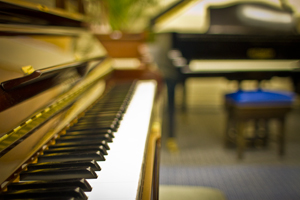Different Piano Finger Techniques

Taking lessons can help you to enjoy playing the piano
Eric Morecambe famously played “all the right notes, but not necessarily in the right order”. In fact, playing the piano is about more than just the notes and the sequence that they’re arranged in. It’s about expression, timing and technique, too; all of these factors will develop in tandem as your skill level improves.
In this article, we’ll look at finger technique; the way a pianist moves their hands and strikes the keys. There are three main approaches you’ll use when you learn the piano.
Beginner Technique
When you learn to play piano, you’ll typically start by playing with one hand on its own before progressing to both hands working as one. This hand usually plays the melody in a piece. It’s easier to play when you only have to worry about what one hand is doing, so you can get the hang of finger technique more quickly this way.
Your teacher may use music that’s marked with numbers, 1 to 5. The number 1 refers to your thumb; the number 5 refers to the little finger (pinky). By following the music and the numbers, you’ll learn to use a particular finger to hit a particular key, and that will help you to understand how your fingers travel over and under each other as you play.
Over time, finger technique becomes second nature as you learn to plan ahead and adjust your technique for each piece of music. Part of the reason you need to practice is to figure out the best and most comfortable technique for a given piece. On tricky passages, you may still see finger numbers marked on the score to help you.
Learning to Play Smoothly
Once you become more accomplished with finger order, you can focus on developing a smooth playing style. The aim is to move your hands so that the keys are struck with the correct amount of pressure. This legato style makes the notes appear to run into each other, creating a smoothness and consistency from one note to the next.
Smooth playing helps to develop a consistent tone and gives you control over the expression and volume level. As you practice, you should find that your play speeds up and your notes flow naturally into each other.
Learning to Add Emphasis
The third phase of learning finger technique is learning staccato play. This is where keys are struck forcefully and separately for emphasis, dramatic effect or punctuation. The aim of staccato technique is to make the notes appear short and sharp while still moving the wrist in a smooth motion, almost like a typist striking the keys on a typewriter with minimal movement in the wrist.
Developing Skills With Piano Lessons
When it comes to finger technique, it’s almost impossible to learn online or from a video tutorial. You’ll need to sit with a teacher who can make suggestions based on your own playing style. It’s important to have a professional watch you play so you don’t develop bad habits that are hard to get rid of later. Also, develop your finger technique on a piano, not an electronic keyboard, or you won’t learn to work with the weight of the keys.
Piano Workshop now offer piano lessons on a Saturday morning. Based in Reigate we are within a short travelling distance of Redhill, Guildford, Leatherhead and Dorking. Contact us for more information.

